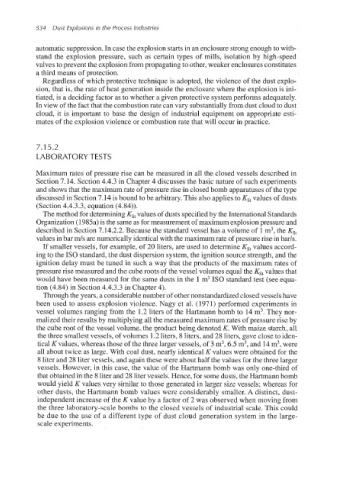Page 567 - Dust Explosions in the Process Industries
P. 567
534 Dust Explosions in the Process Industries
automatic suppression.In case the explosion starts in an enclosure strong enough to with-
stand the explosion pressure, such as certain types of mills, isolation by high-speed
valves to prevent the explosion from propagating to other, weaker enclosures constitutes
a third means of protection.
Regardless of which protective technique is adopted, the violence of the dust explo-
sion, that is, the rate of heat generation inside the enclosure where the explosion is ini-
tiated, is a deciding factor as to whether a given protective system performs adequately.
In view of the fact that the combustion rate can vary substantiallyfrom dust cloud to dust
cloud, it is important to base the design of industrial equipment on appropriate esti-
mates of the explosion violence or combustion rate that will occur in practice.
7.1 5.2
LABORATORYTESTS
Maximum rates of pressure rise can be measured in all the closed vessels described in
Section 7.14, Section 4.4.3 in Chapter 4 discusses the basic nature of such experiments
and shows that the maximum rate of pressure rise in closed bomb apparatuses of the type
discussed in Section 7.14 is bound to be arbitrary.This also applies to K,, values of dusts
(Section 4.4.3.3, equation (4.84)).
The method for determiningKs, values of dusts specified by the InternationalStandards
Organization (1985a)is the same as for measurement of maximum explosionpressure and
described in Section 7.14.2.2. Because the standard vessel has a volume of 1m3,the Ks,
values in bar m/s are numerically identicalwith the maximum rate of pressurerise in bark.
If smaller vessels, for example, of 20 liters, are used to determine Ks, values accord-
ing to the IS0 standard,the dust dispersion system,the ignition source strength, and the
ignition delay must be tuned in such a way that the products of the maximum rates of
pressure rise measured and the cube roots of the vessel volumes equal the Ks, values that
would have been measured for the same dusts in the 1 m3IS0 standard test (see equa-
tion (4.84) in Section 4.4.3.3 in Chapter 4).
Through the years, a considerablenumber of other nonstandardized closed vessels have
been used to assess explosion violence. Nagy et al. (1971) performed experiments in
vessel volumes ranging from the 1.2 liters of the Hartmann bomb to 14 m3.They nor-
malized their results by multiplying all the measured maximum rates of pressure rise by
the cube root of the vessel volume, the product being denoted K. With maize starch, all
the three smallest vessels, of volumes 1.2 liters, 8 liters, and 28 liters, gave close to iden-
tical Kvalues, whereas those of the three larger vessels, of 3 m3,6.5 m3,and 14m3,were
all about twice as large. With coal dust, nearly identical K values were obtained for the
8 liter and 28 liter vessels, and again these were about half the values for the three larger
vessels. However, in this case, the value of the Hartmann bomb was only one-third of
that obtained in the 8 liter and 28 liter vessels. Hence, for some dusts, the Hartmann bomb
would yield K values very similar to those generated in larger size vessels; whereas for
other dusts, the Hartmann bomb values were considerably smaller. A distinct, dust-
independent increase of the K value by a factor of 2 was observed when moving from
the three laboratory-scale bombs to the closed vessels of industrial scale. This could
be due to the use of a different type of dust cloud generation system in the large-
scale experiments.

